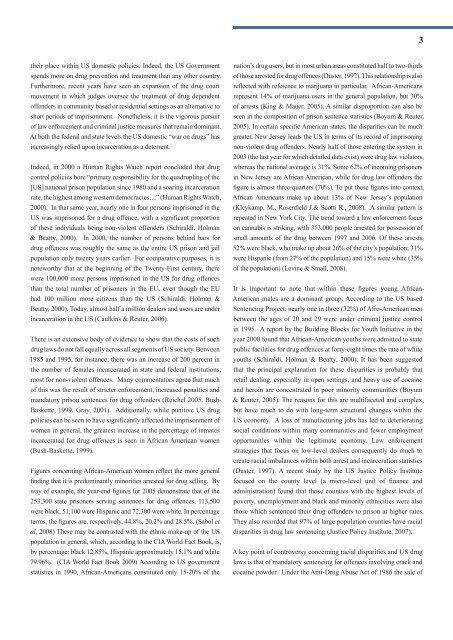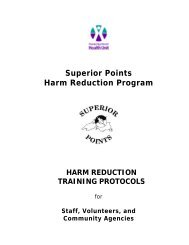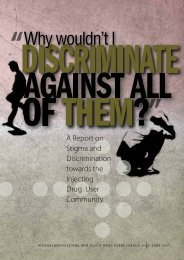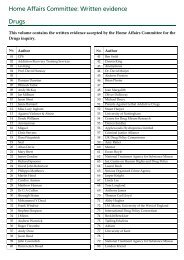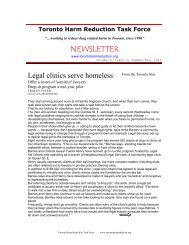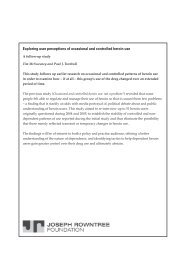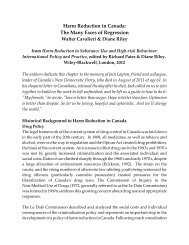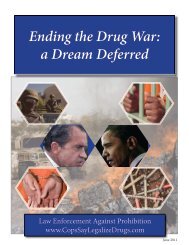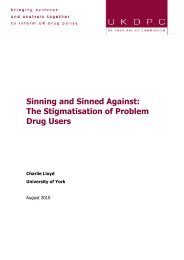The Incarceration of Drug Offenders - The Beckley Foundation
The Incarceration of Drug Offenders - The Beckley Foundation
The Incarceration of Drug Offenders - The Beckley Foundation
- No tags were found...
Create successful ePaper yourself
Turn your PDF publications into a flip-book with our unique Google optimized e-Paper software.
3their place within US domestic policies. Indeed, the US Governmentspends more on drug prevention and treatment than any other country.Furthermore, recent years have seen an expansion <strong>of</strong> the drug courtmovement in which judges oversee the treatment <strong>of</strong> drug dependent<strong>of</strong>fenders in community based or residential settings as an alternative toshort periods <strong>of</strong> imprisonment. Nonetheless, it is the vigorous pursuit<strong>of</strong> law enforcement and criminal justice measures that remain dominant.At both the federal and state levels the US domestic “war on drugs” hasincreasingly relied upon incarceration as a deterrent.Indeed, in 2000 a Human Rights Watch report concluded that drugcontrol policies bore “primary responsibility for the quadrupling <strong>of</strong> the[US] national prison population since 1980 and a soaring incarcerationrate, the highest among western democracies…” (Human Rights Watch,2000). In that same year, nearly one in four persons imprisoned in theUS was imprisoned for a drug <strong>of</strong>fence, with a significant proportion<strong>of</strong> these individuals being non-violent <strong>of</strong>fenders (Schiraldi, Holman& Beatty, 2000). In 2000, the number <strong>of</strong> persons behind bars fordrug <strong>of</strong>fences was roughly the same as the entire US prison and jailpopulation only twenty years earlier. For comparative purposes, it isnoteworthy that at the beginning <strong>of</strong> the Twenty-First century, therewere 100,000 more persons imprisoned in the US for drug <strong>of</strong>fencesthan the total number <strong>of</strong> prisoners in the EU, even though the EUhad 100 million more citizens than the US (Schiraldi, Holman &Beatty, 2000). Today, almost half a million dealers and users are underincarceration in the US (Caulkins & Reuter, 2006).<strong>The</strong>re is an extensive body <strong>of</strong> evidence to show that the costs <strong>of</strong> suchdrug laws do not fall equally across all segments <strong>of</strong> US society. Between1985 and 1995, for instance, there was an increase <strong>of</strong> 200 percent inthe number <strong>of</strong> females incarcerated in state and federal institutions,most for non-violent <strong>of</strong>fences. Many commentators agree that much<strong>of</strong> this was the result <strong>of</strong> stricter enforcement, increased penalties andmandatory prison sentences for drug <strong>of</strong>fenders (Reichel 2005, Bush-Baskette, 1999, Gray, 2001). Additionally, while punitive US drugpolicies can be seen to have significantly affected the imprisonment <strong>of</strong>women in general, the greatest increase in the percentage <strong>of</strong> inmatesincarcerated for drug <strong>of</strong>fences is seen in African American women(Bush-Baskette, 1999).Figures concerning African-American women reflect the more generalfinding that it is predominantly minorities arrested for drug selling. Byway <strong>of</strong> example, the year-end figures for 2005 demonstrate that <strong>of</strong> the253,300 state prisoners serving sentences for drug <strong>of</strong>fences, 113,500were black, 51,100 were Hispanic and 72,300 were white. In percentageterms, the figures are, respectively, 44.8%, 20.2% and 28.5%. (Sabol etal, 2008) <strong>The</strong>se may be contrasted with the ethnic make-up <strong>of</strong> the USpopulation in general, which, according to the CIA World Fact Book, is,by percentage: black 12.85%, Hispanic approximately 15.1% and white79.96%. (CIA World Fact Book 2009) According to US governmentstatistics in 1990, African-Americans constituted only 15-20% <strong>of</strong> thenation’s drug users, but in most urban areas constituted half to two-thirds<strong>of</strong> those arrested for drug <strong>of</strong>fences (Duster, 1997). This relationship is alsoreflected with reference to marijuana in particular. African-Americansrepresent 14% <strong>of</strong> marijuana users in the general population, but 30%<strong>of</strong> arrests (King & Mauer, 2005). A similar disproportion can also beseen in the composition <strong>of</strong> prison sentence statistics (Boyum & Reuter,2005). In certain specific American states, the disparities can be muchgreater. New Jersey leads the US in terms <strong>of</strong> its record <strong>of</strong> imprisoningnon-violent drug <strong>of</strong>fenders. Nearly half <strong>of</strong> those entering the system in2003 (the last year for which detailed data exist) were drug law violators,whereas the national average is 31%. Some 62% <strong>of</strong> incoming prisonersin New Jersey are African American, while for drug law <strong>of</strong>fenders thefigure is almost three-quarters (70%). To put these figures into context,African Americans make up about 13% <strong>of</strong> New Jersey’s population(Kleykamp, M., Rosenfield J.& Scotti R., 2008). A similar pattern isrepeated in New York City. <strong>The</strong> trend toward a law enforcement focuson cannabis is striking, with 353,000 people arrested for possession <strong>of</strong>small amounts <strong>of</strong> the drug between 1997 and 2006. Of these arrests,52% were black, who make up about 26% <strong>of</strong> the city’s population; 31%were Hispanic (from 27% <strong>of</strong> the population) and 15% were white (35%<strong>of</strong> the population) (Levine & Small, 2008).It is important to note that within these figures young African-American males are a dominant group. According to the US basedSentencing Project, nearly one in three (32%) <strong>of</strong> Afro-American menbetween the ages <strong>of</strong> 20 and 29 were under criminal justice controlin 1995. A report by the Building Blocks for Youth Initiative in theyear 2000 found that African-American youths were admitted to statepublic facilities for drug <strong>of</strong>fences at forty-eight times the rate <strong>of</strong> whiteyouths (Schiraldi, Holman & Beatty, 2000). It has been suggestedthat the principal explanation for these disparities is probably thatretail dealing, especially in open settings, and heavy use <strong>of</strong> cocaineand heroin are concentrated in poor minority communities (Boyum& Reuter, 2005). <strong>The</strong> reasons for this are multifaceted and complex,but have much to do with long-term structural changes within theUS economy. A loss <strong>of</strong> manufacturing jobs has led to deterioratingsocial conditions within many communities and fewer employmentopportunities within the legitimate economy. Law enforcementstrategies that focus on low-level dealers consequently do much tocreate racial imbalances within both arrest and incarceration statistics(Duster, 1997). A recent study by the US Justice Policy Institutefocused on the county level (a micro-level unit <strong>of</strong> finance andadministration) found that those counties with the highest levels <strong>of</strong>poverty, unemployment and black and minority ethnicities were alsothose which sentenced their drug <strong>of</strong>fenders to prison at higher rates.<strong>The</strong>y also recorded that 97% <strong>of</strong> large population counties have racialdisparities in drug law sentencing (Justice Policy Institute, 2007).A key point <strong>of</strong> controversy concerning racial disparities and US druglaws is that <strong>of</strong> mandatory sentencing for <strong>of</strong>fences involving crack andcocaine powder. Under the Anti-<strong>Drug</strong> Abuse Act <strong>of</strong> 1986 the sale <strong>of</strong>


